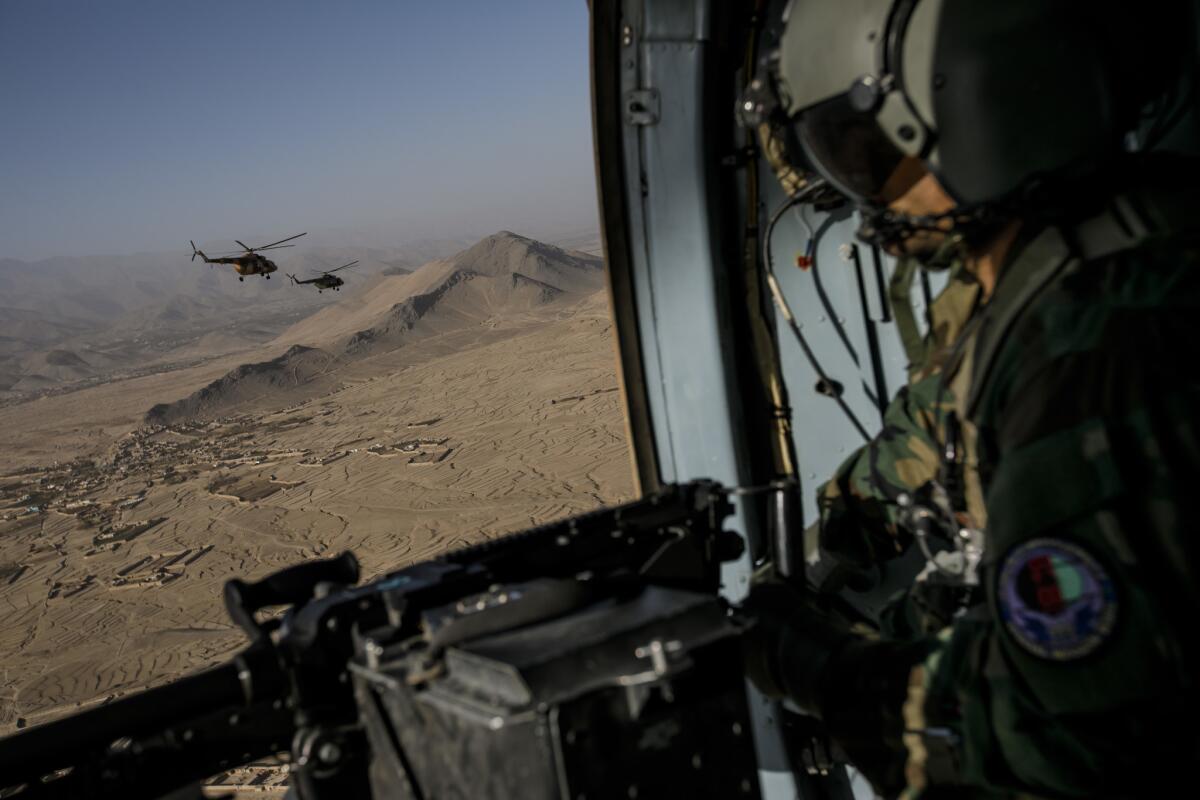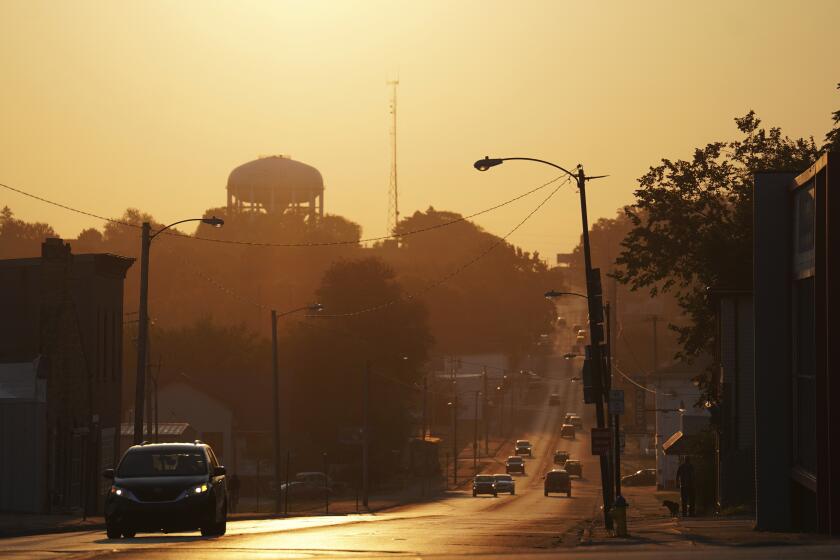These are Afghanistan’s best troops. The U.S. is backing a plan to create many more of them

His knees swaying and his smooth face shadowed by an oversized helmet, Amir Khan Mohammad Naim did not look like an elite law enforcement officer.
But when a call went out in his rural hometown for recruits to join Afghanistan’s police commandos, the 21-year-old farmer’s son from the quiet province of Daykundi did not hesitate.
“My duty is to secure Afghanistan, meter by meter,” Naim said recently between drills at a police training center north of Kabul, where NATO advisors are overseeing part of a major transformation in Afghan security forces.
While conventional Afghan soldiers and police struggle to hold their ground against insurgents, the country’s special forces have been a rare success story, routinely responding first to attacks and leading the majority of offensive operations. Now the U.S.-led coalition is backing a plan to nearly double the size of the elite units in an effort to take back territory from the militants.
The $200-million effort is part of a four-year plan to bolster security at a time when government forces have seen their grip on the country slip to its weakest since 2001. More than one-third of Afghanistan’s 33 million people live in areas either controlled or contested by the Taliban, Islamic State or other insurgent groups, according to the most recent U.S. military estimates.
At the same time, Afghan forces are suffering heavy casualties, with nearly 800 soldiers and police killed in one recent month alone.
The units targeted for growth — including paramilitary police forces, army commandos and a burgeoning air wing — are widely seen as the country’s most capable fighters. They now form less than 6% of Afghanistan’s 350,000-member security forces.
The plan will raise the number of elite army, police and air forces from 19,000 to nearly 34,000, according to the U.S.-led military coalition training Afghan troops.
That will require attracting new recruits, converting some conventional soldiers to commandos, furnishing them with better training and more logistical support, and ensuring they aren’t assigned to static duties like manning checkpoints, where they are vulnerable to ambushes.
“This approach focuses increased attention and resources on forces that have proven most effective on the battlefield,” the Pentagon said in a June report to Congress.
More than 16 years into the Afghan war, the U.S. has already spent nearly $70 billion to build, train and equip the Afghan army and police, which still routinely fail to secure territory, prevent major insurgent attacks and conduct coordinated operations without assistance from coalition advisors.
Atiqullah Baryalai, a former Afghan deputy defense minister, said the plan could be effective if it allows government troops to conduct more aggressive operations.
“Most of the casualties in the security forces result from sitting on defense lines,” he said. “The reinforcement of special operations forces will help them to be in an offensive position … which will consequently result in a reduction of casualties.”
But critics said the emphasis on special forces risks diluting the quality of the elite units.
A recent commentary published by the Afghanistan Analysts Network, a Kabul-based research organization, said the strategy also could paper over the problem that the regular army and police “are apparently not up to their main task, which would be bearing the brunt of the fight, in both offensive operations to wrestle territory back from the insurgency and defensive operations to hold captured areas.”
Coalition officials say an increase in the size of the NATO training mission — including nearly 4,000 additional U.S. forces authorized by President Trump — will bring the number of international troops in Afghanistan to 20,000 by next year and allow for closer advising of Afghan soldiers and police, including the elite units.
The paramilitary police include a rapid-action force that has conducted more than 1,500 operations this year, the vast majority without NATO advisors, Afghan officials said. The Crisis Response Unit, also known as the 222, is often the first to arrive and neutralize high-profile attacks — such as in March, when militants dressed in lab coats opened fire inside Kabul’s main military hospital, killing 50 people.
The interior ministry plans to add three new units totaling about 2,000 police to the existing force of 7,200. Many of the recruits undergoing the six-month training program are high school graduates who have never served in the security forces before, but simply answered ads in the media.
“Most are volunteers who want to serve their country,” said Maj. Mohammad Asif Nawabi, commander of the Special Police Training Center in Kabul. “They don’t worry about being killed or injured. Once they finish our training, they are prepared to fight.”
U.S. officials said Afghans continue to struggle with providing logistical support to units in the field. Part of the expansion plan includes developing the capability of the Special Mission Wing, a small aerial unit that provides transport and limited artillery support to elite ground forces.
The unit is set to grow from 826 troops to nearly 1,300 and beef up its fleet of American-made PC-12 surveillance aircraft and Russian Mi-17 helicopters, Afghan officials said. In the past it has had trouble finding enough qualified pilots and maintenance personnel, leaving many of its aircraft grounded with no one to fly them.
“It takes two to three years to train one pilot, and it’s very expensive,” said Brig. Gen. Fahim Ramin, the unit’s commander. “So we’re going to grow slowly. We don’t need quantity. We need quality.”
The unit’s importance was clear during the hospital attack in March, when Ramin himself piloted a helicopter to the roof of the building twice, dropping off 40 paramilitaries who helped quell the firing inside.
“I wasn’t sure if that roof could handle a 26,000-pound helicopter, but we did it,” Ramin said. “I think it was good for our morale – our ground troops have to know that we can support them.”
The largest special operations unit, the Afghan army commandos, will see the greatest expansion, growing from 11,300 to 23,300. That will include the addition of two armored vehicle brigades, giving the commandos better ground assault capability, U.S. officials said.
Afghan officials are racing to train men to fill those ranks. At a graduation ceremony in Kabul in October, 830 newly minted commandos donned the unit’s maroon berets and showed off their M4 rifles.
Within weeks, commanders said, the graduates, including many conventional soldiers who underwent additional training, would be deployed to outlying provinces.
A former army battalion commander, 45-year-old Abdul Wahid Jabali, said he was drawn to the commandos by seeing them on the battlefield, sometimes accompanied by U.S. special operations trainers, including Army Rangers. A strapping former boxer with thick gray sideburns, Jabali said the commandos seemed better equipped and organized than his forces.
The father of seven said there were other perks: a salary of $270 a month, compared to $200 in the regular army, plus more frequent leave.
“My eldest son is 20 and I want him to be a commando as well,” Jabali said.
Follow @SBengali on Twitter for more news from South Asia
Sign up for Essential California
The most important California stories and recommendations in your inbox every morning.
You may occasionally receive promotional content from the Los Angeles Times.








